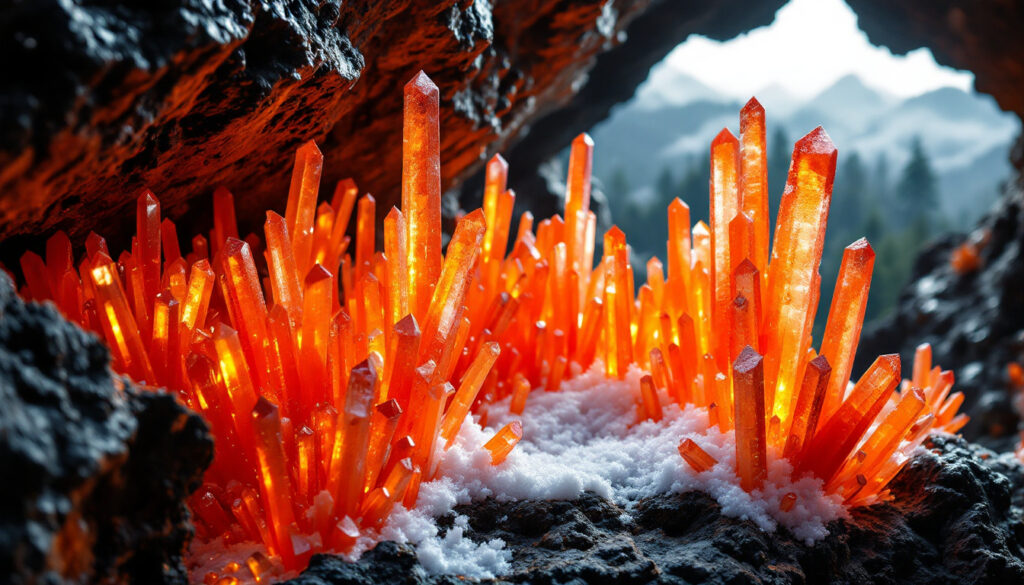What is Crocoite?
Crocoite is a stunning mineral with a chemical composition of lead chromate (PbCrO₄) that crystallizes in the monoclinic system. This remarkable mineral forms prismatic, elongated crystals with nearly square cross-sections that can reach impressive lengths exceeding 10 cm. The most striking feature of crocoite is undoubtedly its vibrant orange-red to hyacinth-red color that seems to capture the essence of fire itself when displayed against dark rock matrices.
Unlike many minerals, crocoite possesses a sectile nature, meaning it can be cut or bent slightly like a soft metal without completely shattering. This property, combined with its Mohs hardness of 2.5-3, makes it extremely delicate both physically and chemically. Collectors and museums must take special precautions when handling specimens, as even minor pressure can damage the fragile crystals.
Another fascinating characteristic of crocoite is its sensitivity to light. With prolonged exposure to strong illumination, these fiery crystals can gradually darken or lose their transparency. Even the Smithsonian Institution has observed this gradual transformation in their specimens, leading to careful preservation practices for this Tasmanian treasure.
The Mineral's Composition and Properties
The distinctive properties of crocoite stem directly from its chemical composition. As a lead chromate, the mineral contains both lead and chromium in an oxidized state, creating the perfect conditions for its spectacular coloration. The chromate ion (CrO₄²⁻) is responsible for the intense orange-red hue that makes crocoite immediately recognizable to mineral enthusiasts worldwide.
When examining crocoite under magnification, one can observe its perfect cleavage in one direction, which contributes to its sectile nature. The crystals typically display a resinous to adamantine luster when fresh, adding to their visual appeal. With a specific gravity ranging between 5.9 and 6.1, crocoite feels unexpectedly heavy for its size – another clue to its lead content.
Many specimens from Tasmania's Adelaide Mine exhibit hollow terminations resulting from rapid fibrous growth, creating a distinctive "jackstraw" appearance that collectors prize. This unique crystal habit is rarely seen in specimens from other global localities, further cementing Tasmania's reputation for producing the world's finest crocoite in Tasmania.
Visual Characteristics That Make It Unique
Crocoite's slender, needle-like crystals create a visual spectacle unlike almost any other mineral on Earth. When found in clusters, these fiery red crystals radiate outward like frozen flames against the contrasting dark matrix or snow-white dundite. It's this dramatic presentation that has earned crocoite its reputation as "one of the most visually striking minerals known to man."
Collectors and mineral enthusiasts often compare Tasmanian crocoite to "hot coals" or "flames" trapped in stone. The mineral's intense color appears almost artificial in its brilliance, leading first-time observers to question whether such vivid natural crystals could possibly be genuine. Yet these spectacular formations are entirely the product of Tasmania's unique geological conditions.
The contrast of brilliant hyacinth-red crocoite against white dundite or dark iron-manganese matrix creates visual compositions of exceptional beauty. In the finest specimens, crocoite crystals may form radiating sprays, parallel growths, or individual prismatic needles that catch and reflect light in mesmerizing ways. This visual drama has cemented crocoite's status as one of the most desirable collector minerals worldwide.
Where Is Crocoite Found in Tasmania?
Tasmania's western region hosts the world's premier crocoite deposits, concentrated primarily in a mineral-rich area known as the Dundas Mineral Field. This rugged, mountainous terrain has yielded spectacular specimens since the mineral's formal identification in the region during 1891-1893. While crocoite occurs in a handful of locations globally, Tasmania's deposits are unrivaled in terms of crystal size, quality, and abundance.
The mineral's distribution across Tasmania follows specific geological patterns, typically appearing where lead-bearing deposits intersect with chromium-rich rock formations. This fortuitous geological convergence has created the perfect laboratory for crocoite's natural development over millions of years.
The Dundas Mineral Field
The Dundas Mineral Field, nestled in western Tasmania's rugged mountains, has been the primary source of world-class crocoite specimens since the early 1890s. This mineral-rich region became famous after spectacular discoveries that quickly overshadowed all previously known crocoite localities worldwide.
The Adelaide Mine stands as perhaps the most celebrated crocoite location, with historical accounts describing tunnels where crocoite literally "coated the roof" in brilliant red needles. Some of these formations created stunning cavities lined with delicate, slender crystals that seemed to defy gravity. The mine's specific geological conditions produced predominantly fibrous crystals with hollow terminations, creating a distinctive "jackstraw" appearance that collectors immediately recognize as typical of this locality.
In contrast, the nearby Red Lead Mine became known for producing solid, fully terminated crystals of exceptional quality. These specimens typically feature more robust crystal formations with greater structural integrity, making them particularly prized by serious collectors and museums.
The West Comet Mine, another significant producer within the Dundas Mineral Field, historically yielded some of the largest crocoite crystals ever discovered, with documented specimens reaching lengths of up to 12 cm. These extraordinary crystals represent the pinnacle of crocoite formation, requiring perfect conditions maintained over extensive periods to achieve such remarkable dimensions.
Other Significant Tasmanian Localities
While the Dundas Mineral Field dominates discussions of Tasmanian crocoite, several other important localities have contributed to the island's mineral fame. The Heazelwood Silver-Lead Mine near Waratah holds the distinction of being the site of the first Tasmanian crocoite discovery in 1884, though at the time, the mineral was initially misidentified as yellow lead carbonate or wulfenite.
The Magnet Mine, also near Waratah, produced interesting crocoite specimens where the ore body ran through chromium-rich country rock. This mine demonstrated the essential geological prerequisite for crocoite formation—the intersection of lead-bearing deposits with chromium-rich host rocks.
What makes Tasmania's crocoite localities so special is their alignment along brecciated fault zones near chromium-rich rock belts. This geological pattern provided the essential pathways for mineral-rich fluids to circulate, creating the perfect conditions for crocoite crystallization. The island's complex tectonic history created multiple such zones, explaining why Tasmania hosts numerous high-quality crocoite localities within a relatively small geographic area.
How Did Crocoite Form in Tasmania?
The formation of crocoite in Tasmania represents a remarkable geological convergence that has occurred in only a handful of locations worldwide. Understanding this process helps explain why Tasmania's specimens remain unrivaled in quality and abundance, even after more than 130 years of collection and study.
The mineral's development required a precise sequence of geological events spanning millions of years, from the initial deposition of lead-bearing ores to the weathering processes that ultimately created the conditions for crocoite crystallization. This natural alchemy transformed common elements into one of Earth's most visually striking minerals.
The Perfect Geological Conditions
Crocoite formed in the oxidized zones (gossans) of lead-silver deposits, representing the final chapter in a complex geological story that began in the late Cambrian period, approximately 485-490 million years ago. The process required a specific geological convergence of key elements that Tasmania uniquely provided.
The foundation of crocoite formation began with rich seams of lead ore, primarily galena (lead sulfide), deposited during Tasmania's late Cambrian period. These lead deposits needed to develop in proximity to chromium-rich ultramafic rocks like serpentinite, which served as the source of the chromium component. Over millions of years, exposure to surface waters and oxygen created oxidized caps (gossans) atop these mineral deposits, setting the stage for crocoite's creation.
The critical chemical pathway involved dissolved chromium from adjacent serpentine rocks migrating into lead veins through groundwater movement. As these mineral-rich solutions percolated through the oxidizing lead deposits, they created the perfect chemical environment for crocoite to crystallize precisely where lead met chromate in an oxygen-rich environment.
Tasmania's brecciated fault zones proved especially conducive to crocoite formation, as they allowed water and oxygen to penetrate deeply into the mineral deposits. This enhanced oxidation process accelerated the complex reactions necessary for crocoite crystallization, explaining why the mineral often appears in proximity to these geological features.
The Unique Chemistry of Tasmanian Deposits
The exceptional quality of Tasmanian crocoite stems directly from the unique chemistry of its mineral deposits. The island's geological history created the perfect recipe for premium crocoite formation, combining elements that rarely converge in nature.
Tasmania's crocoite deposits typically align along brecciated fault zones that allowed water and oxygen to enter the mineral system. These fractured pathways facilitated the oxidation of primary lead sulfides and the incorporation of chromium from nearby ultramafic rocks, creating the perfect chemical soup for epithermal deposits formation.
The surrounding geology contributed additional elements that influenced the mineral assemblage. Iron and manganese oxides colored the gossan matrix, providing the dark background that so dramatically showcases crocoite's fiery crystals. Meanwhile, aluminum and phosphorus from nearby sedimentary rocks contributed to rarities like dundite, the snow-white lead aluminum carbonate frequently associated with Tasmanian crocoite.
What makes Tasmania's crocoite deposits so exceptional is that only a handful of locations globally had this "magic recipe" of lead and chromium in the precise geological configuration needed for premium crystal development. Most other world localities lacked either the quality of the lead deposits, the proximity of chromium sources, or the ideal oxidation conditions, resulting in crocoite of lesser quality or abundance.
Why Is Tasmanian Crocoite Considered the World's Best?
There exists a broad consensus among mineralogists, collectors, and museum curators that Tasmania produces "the world's most stellar crocoite specimens." This reputation wasn't earned overnight but developed through 130+ years of consistent production of exceptional material that outshines specimens from all other global localities.
The distinction isn't merely subjective appreciation but based on measurable qualities that set Tasmanian crocoite apart. From crystal size and color intensity to abundance and crystal perfection, Tasmania's specimens consistently establish the gold standard by which all other crocoite is judged.
Superior Qualities of Tasmanian Specimens
Tasmanian crocoite specimens are notable for several superior qualities that distinguish them from crocoite found elsewhere. The size of the crystals represents perhaps the most immediately apparent advantage, with documented specimens reaching lengths exceeding 12 cm from the West Comet Mine. These dimensions far surpass typical crystals from other localities, which rarely exceed a few centimeters.
The color intensity of Tasmanian crocoite also stands out, displaying a hyacinth-red brilliance that suggests a higher chromate ion concentration compared to specimens from Russia or other locations. This vibrant coloration, coupled with the mineral's natural luster, creates a visual impact that photographs can barely capture.
Over the last 130 years, Tasmania has yielded abundant, beautifully crystallized material that has supplied major museums and private collections worldwide. The consistent quality across numerous specimens demonstrates that Tasmania's exceptional crocoite isn't merely the result of a few lucky finds but represents a genuine geological superiority in the conditions that formed these remarkable crystals.
Exceptional Tasmanian specimens are displayed in major museums worldwide, including the Smithsonian Institution, which houses some of the finest examples ever recovered. These museum pieces serve as the reference standard when evaluating crocoite, with their Tasmanian origin explicitly noted as a mark of quality.
Comparison to Other Global Localities
Crocoite was originally discovered in Siberian gold fields in Russia's Ural Mountains, and for many years, these specimens represented the best-known examples of the mineral. However, by 1894, collectors and mineralogists widely recognized that Tasmanian specimens had surpassed Russian material in every significant quality metric.
The Russian specimens, while historically important, typically feature smaller, less vibrant crystals without the spectacular displays commonly found in Tasmanian material. Other global localities, including occurrences in Brazil and the United States, produce even less impressive specimens, often consisting of microcrystalline material or thin coatings rather than the dramatic crystal formations that make Tasmanian crocoite so desirable.
Tasmania remains the premier source for fine crocoite specimens globally, with no other place in Australia or the world producing comparable material. This exceptional quality explains why locality information is so important in crocoite specimens—a Tasmanian origin immediately signals superior quality to knowledgeable collectors.
The island's geological uniqueness created the perfect conditions for crocoite formation on a scale and quality unmatched elsewhere. While other localities may occasionally produce interesting specimens, none have demonstrated the consistent excellence that has made Tasmanian crocoite legendary in mineralogical circles.
What Minerals Commonly Occur with Crocoite?
Crocoite rarely occurs in isolation. Instead, it typically forms as part of a diverse mineral assemblage that tells the complex story of Tasmania's secondary mineral development. These associated minerals often enhance the visual appeal of crocoite specimens while providing valuable geological context.
Understanding these mineral associations helps collectors and scientists appreciate the sophisticated chemistry that produced these remarkable formations. The interplay of lead, chromium, aluminum, and other elements created what one geologist described as "a veritable mineral menagerie" within Tasmania's oxidized ore deposits.
Associated Secondary Minerals
Dundite, a soft white lead aluminum carbonate named after the Dundas locality, frequently accompanies crocoite in Tasmanian specimens. This mineral creates a striking contrast with crocoite's fiery red crystals, enhancing the visual drama of the finest specimens. Dundite's occurrence alongside crocoite represents a unique Tasmanian phenomenon, as the mineral has not been documented in crocoite deposits elsewhere.
Phoenicochroite, a basic lead chromate appearing as dark red crystals, often forms in the same oxidized environments as crocoite. While less visually dramatic than crocoite, phoenicochroite provides evidence of variations in the oxidation conditions and chromium concentration during mineral formation.
Cerussite (lead carbonate) frequently appears with Tasmanian crocoite, forming translucent to transparent crystals that add complexity to the mineral assemblage. This association demonstrates how varying carbon dioxide levels in the mineralizing fluids influenced which lead compounds crystallized at different times and locations within the deposit.
Anglesite (lead sulfate) forms clear or yellow crystals on the same matrix as crocoite, representing another pathway for lead mineralization in these complex secondary environments. Its presence indicates areas where sulfate ions remained available during the oxidation process.
Less common associates include pyromorphite, mimetite, vauquelinite, and even native gold, each contributing to the rich diversity of Tasmania's secondary mineral suites. These minerals appear in varying combinations and proportions depending on the specific chemistry of individual deposit zones.
The Mineral Paragenesis
The secondary minerals found with crocoite precipitated from the same mineral-rich fluids, creating a complex paragenetic sequence that reveals the changing chemical conditions as these deposits weathered. Understanding this sequence helps scientists reconstruct the environmental conditions that prevailed during different stages of mineral formation.
These minerals form a "veritable mineral menagerie" telling the story of complex gossan chemistry as primary lead sulfides oxidized and recombined with various elements present in the groundwater. The recombination of lead, chromium, sulfur, phosphorus, and other elements created diverse mineral assemblages that vary even within short distances in the same deposit.
The visual contrast between white dundite and orange-red crocoite creates particularly striking specimens that showcase the varying chemistry within these oxidized zones. Such dramatic mineral associations make Tasmanian specimens especially desirable to collectors, who prize the aesthetic combinations as much as the crocoite itself.
By studying these mineral associations, geologists have gained valuable insights into how secondary minerals form in weathering environments, particularly the mobility of elements like chromium that are typically considered relatively immobile in surface conditions. Tasmania's ore deposits geology has thus contributed significantly to scientific understanding beyond their obvious aesthetic appeal.
What Is the Historical Significance of Crocoite?
Crocoite holds a special place in both mineralogical history and Tasmania's heritage. From its role in the discovery of a fundamental element to its status as Tasmania's official state mineral, crocoite has transcended its geological origins to become a cultural and scientific icon.
The mineral's history in Tasmania extends back to the late 19th century, when prospectors and miners first encountered the brilliant red crystals in the island's western mountains. Since those early discoveries, crocoite has become inextricably linked with Tasmania's identity and mining heritage.
Discovery and Early Recognition
Crocoite was first reported in Tasmania at the Heazelwood Mine in 1884, though the initial identification was incorrect. Early miners misidentified the mineral, with yellow lead carbonate erroneously described as wulfenite. It wasn't until 1891-1893 that spectacular discoveries at Dundas properly identified the mineral and established Tasmania as a world-class locality for crocoite in Tasmania.
Tasmanian geologists formally confirmed the mineral as crocoite by 1893, recognizing its similarity to the already-known Russian material. Interestingly, Tasmanian crocoite wasn't listed in James Dwight Dana's 1892 mineralogy updates, indicating how quickly the mineral rose from obscurity to fame in the scientific community.
The discoveries at Dundas between 1891 and 1893
Ready to Discover the Next Major ASX Mineral Find?
Don't miss out on potentially transformative mining discoveries that could deliver substantial returns. Visit Discovery Alert's discoveries page to explore historic examples and begin your 30-day free trial of real-time alerts powered by the proprietary Discovery IQ model.




